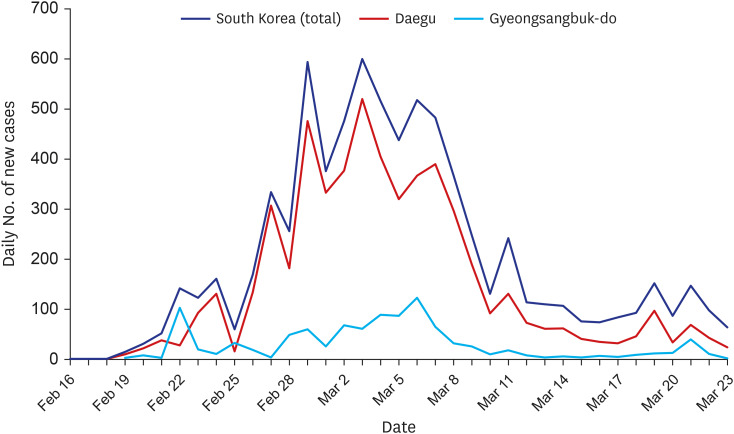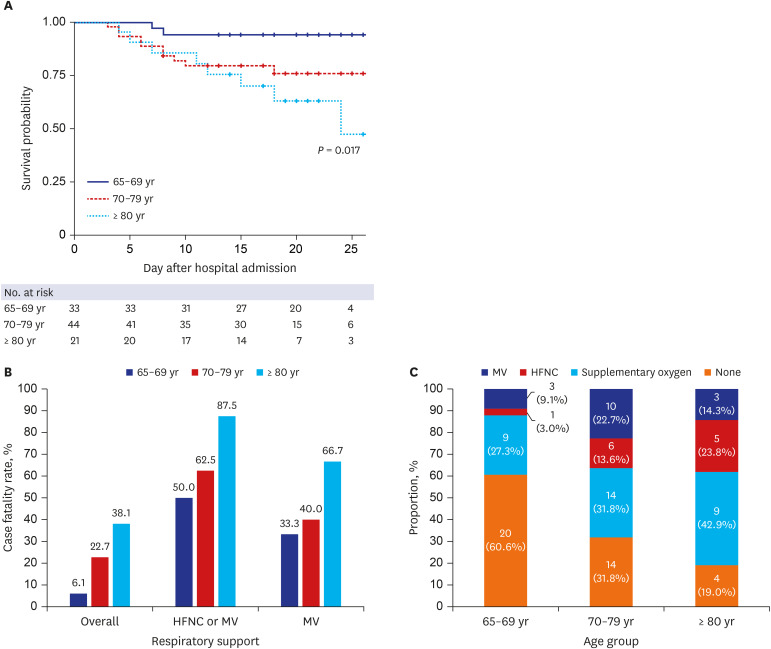Risk Factors for Mortality and Respiratory Support in Elderly Patients Hospitalized with COVID-19 in Korea
- Affiliations
-
- 1Division of Infectious Diseases, Department of Medicine, Keimyung University Dongsan Hospital, Keimyung University School of Medicine, Daegu, Korea
- 2Division of Infectious Diseases, Department of Medicine, Samsung Medical Center, Sungkyunkwan University School of Medicine, Seoul, Korea
- 3Division of Infectious Diseases, Department of Medicine, Dankook University School of Medicine, Cheonan, Korea
- 4Division of Infectious Diseases, Department of Medicine, Seongnam Citizens Medical Center, Seongnam, Korea
- 5Division of Infectious Diseases, Department of Internal Medicine, School of Medicine, Kyungpook National University, Daegu, Korea
- KMID: 2502927
- DOI: http://doi.org/10.3346/jkms.2020.35.e223
Abstract
- Background
The mortality risk of coronavirus disease 2019 (COVID-19) is higher in patients with older age, and many elderly patients are reported to require advanced respiratory support.
Methods
We reviewed medical records of 98 patients aged ≥ 65 years who were hospitalized with COVID-19 during a regional outbreak in Daegu/Gyeongsangbuk-do province of Korea. The outcome measures were in-hospital mortality and the treatment with mechanical ventilation (MV) or high-flow nasal cannula (HFNC).
Results
The median age of the patients was 72 years; 55.1% were female. Most (74.5%) had at least one underlying condition. Overall case fatality rate (CFR) was 20.4%, and median time to death after admission was 8 days. The CFR was 6.1% among patients aged 65–69 years, 22.7% among those aged 70–79 years, and 38.1% among those aged ≥ 80 years. The CFR among patients who required MV was 43.8%, and the proportion of patients received MV/HFNC was 28.6%. Nosocomial acquisition, diabetes, chronic lung diseases, and chronic neurologic diseases were significant risk factors for both death and MV/HFNC. Hypotension, hypoxia, and altered mental status on admission were also associated with poor outcome. CRP > 8.0 mg/dL was strongly associated with MV/HFNC (odds ratio, 26.31; 95% confidence interval, 7.78–88.92; P < 0.001), and showed better diagnostic characteristics compared to commonly used clinical scores.
Conclusion
Patients aged ≥ 80 years had a high risk of requiring MV/HFNC, and mortality among those severe patients was very high. Severe initial presentation and laboratory abnormalities, especially high CRP, were identified as risk factors for mortality and severe hospital course.
Keyword
Figure
Cited by 3 articles
-
Coping with Dementia in the Middle of the COVID-19 Pandemic
Nayoung Ryoo, Jung-Min Pyun, Min Jae Baek, Jeewon Suh, Min Ju Kang, Min Jeong Wang, Young Chul Youn, Dong Won Yang, Seong Yoon Kim, Young Ho Park, SangYun Kim
J Korean Med Sci. 2020;35(42):e383. doi: 10.3346/jkms.2020.35.e383.Clinical Features of COVID-19 in Uzbekistan
KyungHee Kim, Jae Wook Choi, Juyoung Moon, Habibulla Akilov, Laziz Tuychiev, Bakhodir Rakhimov, Kwang Sung Min
J Korean Med Sci. 2020;35(45):e404. doi: 10.3346/jkms.2020.35.e404.In-hospital mortality prediction using frailty scale and severity score in elderly patients with severe COVID-19
Yong Sub Na, Jin Hyoung Kim, Moon Seong Baek, Won-Young Kim, Ae-Rin Baek, Bo young Lee, Gil Myeong Seong, Song-I Lee
Acute Crit Care. 2022;37(3):303-311. doi: 10.4266/acc.2022.00017.
Reference
-
1. World Health Organization. Coronavirus Disease 2019 (COVID-19) Situation Report - 65. Geneva: World Health Organization;2020.2. Kim JY, Ko JH, Kim Y, Kim YJ, Kim JM, Chung YS, et al. Viral load kinetics of SARS-CoV-2 infection in first two patients in Korea. J Korean Med Sci. 2020; 35(7):e86. PMID: 32080991.
Article3. Zou L, Ruan F, Huang M, Liang L, Huang H, Hong Z, et al. SARS-CoV-2 viral load in upper respiratory specimens of infected patients. N Engl J Med. 2020; 382(12):1177–1179. PMID: 32074444.
Article4. Tian S, Hu N, Lou J, Chen K, Kang X, Xiang Z, et al. Characteristics of COVID-19 infection in Beijing. J Infect. 2020; 80(4):401–406. PMID: 32112886.
Article5. Wu C, Chen X, Cai Y, Xia J, Zhou X, Xu S, et al. Risk factors associated with acute respiratory distress syndrome and death in patients with coronavirus disease 2019 pneumonia in Wuhan, China. JAMA Intern Med. Forthcoming. 2020; DOI: 10.1001/jamainternmed.2020.0994.
Article6. Wu Z, McGoogan JM. Characteristics of and important lessons from the coronavirus disease 2019 (COVID-19) outbreak in China: summary of a report of 72 314 cases from the Chinese Center for Disease Control and Prevention. JAMA. 2020; 323(13):1239.7. Onder G, Rezza G, Brusaferro S. Case-fatality rate and characteristics of patients dying in relation to COVID-19 in Italy. JAMA. Forthcoming. 2020; DOI: 10.1001/jama.2020.4683.
Article8. Korean Society of Infectious Diseases. Korean Society of Pediatric Infectious Diseases. Korean Society of Epidemiology. Korean Society for Antimicrobial Therapy. Korean Society for Healthcare-associated Infection Control and Prevention. Korea Centers for Disease Control and Prevention. Report on the epidemiological features of coronavirus disease 2019 (COVID-19) outbreak in the Republic of Korea from January 19 to March 2, 2020. J Korean Med Sci. 2020; 35(10):e112. PMID: 32174069.9. Korean Society of Infectious Diseases and Korea Centers for Disease Control and Prevention. Analysis on 54 mortality cases of coronavirus disease 2019 in the Republic of Korea from January 19 to March 10, 2020. J Korean Med Sci. 2020; 35(12):e132. PMID: 32233161.10. Huang C, Wang Y, Li X, Ren L, Zhao J, Hu Y, et al. Clinical features of patients infected with 2019 novel coronavirus in Wuhan, China. Lancet. 2020; 395(10223):497–506. PMID: 31986264.
Article11. Subbe CP, Kruger M, Rutherford P, Gemmel L. Validation of a modified Early Warning Score in medical admissions. QJM. 2001; 94(10):521–526. PMID: 11588210.
Article12. Royal College of Physicians. National Early Warning Score (NEWS) 2: Standardising the Assessment of Acute-illness Severity in the NHS. Updated Report of a Working Party. London: Royal College of Physicians;2017.13. Korea Centers for Disease Control and Prevention. Updates on COVID-19 in Republic of Korea (25 March 2020). Cheongju: Korea Centers for Disease Control and Prevention;2020.14. Yang X, Yu Y, Xu J, Shu H, Xia J, Liu H, et al. Clinical course and outcomes of critically ill patients with SARS-CoV-2 pneumonia in Wuhan, China: a single-centered, retrospective, observational study. Lancet Respir Med. 2020; 8(5):475–481. PMID: 32105632.
Article15. Zhou F, Yu T, Du R, Fan G, Liu Y, Liu Z, et al. Clinical course and risk factors for mortality of adult inpatients with COVID-19 in Wuhan, China: a retrospective cohort study. Lancet. 2020; 395(10229):1054–1062. PMID: 32171076.
Article16. Arentz M, Yim E, Klaff L, Lokhandwala S, Riedo FX, Chong M, et al. Characteristics and Outcomes of 21 Critically Ill Patients With COVID-19 in Washington State. JAMA. 2020; 323(16):1612.
Article17. Wang D, Hu B, Hu C, Zhu F, Liu X, Zhang J, et al. Clinical characteristics of 138 hospitalized patients with 2019 novel coronavirus-infected pneumonia in Wuhan, China. JAMA. 2020; 323(11):1061.
Article18. Zhang JJ, Dong X, Cao YY, Yuan YD, Yang YB, Yan YQ, et al. Clinical characteristics of 140 patients infected with SARS-CoV-2 in Wuhan, China. Allergy. Forthcoming. 2020; DOI: 10.1111/all.14238.
Article
- Full Text Links
- Actions
-
Cited
- CITED
-
- Close
- Share
- Similar articles
-
- Clinical characteristics and risk factors for mortality of patients hospitalized with COVID-19 in Korea
- Risk Factors for Mortality in Hospitalized Patients with COVID-19: An Overview in a Mexican Population
- Factors Associated With Fear of Coronavirus Disease 2019 Stigmatization in the Elderly
- Perspectives of Ketamine Use in COVID-19 Patients
- The impact of the COVID-19 pandemic on in-hospital mortality in patients admitted through the emergency department



